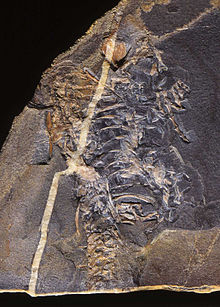Casineria
|
Casineria Temporal range: Early Carboniferous, 340 Ma |
|
|---|---|
 |
|
| Holotype fossil from the Lower Carboniferous of Scotland, UK | |
| Scientific classification | |
| Kingdom: | Animalia |
| Phylum: | Chordata |
| Clade: | Amniota (?) |
| Genus: |
†Casineria Paton, Smithson & Clack, 1999 |
| Type species | |
|
†Casineria kiddi Paton, Smithson & Clack, 1999 |
|
Casineria is an extinct genus of tetrapod which lived about 340 million years ago in the Mississippian epoch. Its name, Casineria, is a latinization of Cheese Bay, the site near Edinburgh, where it was found. It lived in what was then a fairly dry environment in Scotland.
It is a transitional fossil noted for its mix of primitive (amphibian) and advanced (reptilian) characters, putting it at or very near the origin of the amniotes. The sole find is lacking key elements (most of the skull and the whole lower body is missing), making exact analysis difficult.
Casineria was a small animal with a total length estimated to have been 15 centimeters. Its small size would have made it ideal for hunting the invertebrates of the Carboniferous.
This earliest amniote had five fingers with claws on each hand, and marks the earliest clawed foot. Claws being a feature intimately bound to the formation of keratinous scales in reptiles, Casineria would in life in all likelihood bear scaly, reptilian type skin. In life, it would resemble a small lizard.
Likely being among the first amniotes in the biological sense, it would have laid amniotic egg not dependent on being laid in water to survive, possibly hiding them in damp vegetation or hollowed out tree stumps. This has been inferred from the fact that Casineria was found in rocks showing a rather dry environment. In the early Carboniferous period before the appearance of Casineria, vertebrates were primarily aquatic, only spending part of their time on land. Casineria and its relatives were the first vertebrates to live and reproduce on land.
In 1992, an amateur fossil collector spotted the remnants of this four-legged creature on the shore of Cheese Bay, Scotland. For the next five years, the fossil languished at the National Museum of Scotland in Edinburgh while researchers focused on other projects. Around 1997, work began to expose the remainder of the fossil from the surrounding matrix. The work revealed that the animal probably lived in an environment much drier than previously understood. The findings were first reported in the April 8, 1999 edition of Nature.
While retaining a general build like those found in the amphibian reptiliomorph groups like Seymouriamorpha and Diadectomorpha, Casineria also shows features that tie it in with early reptiles, notably a generally gracile build with light leg bones, unfused ankles and toes terminating in claws. This would enable the animal to use their feet actively in traction, rather than as holdfasts, an indication of a primarily terrestrial lifestyle. These traits show it was more closely related to amniotes than to other known reptiliomorph amphibians.
...
Wikipedia
